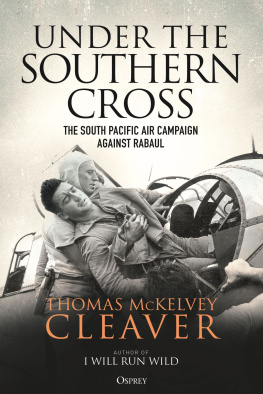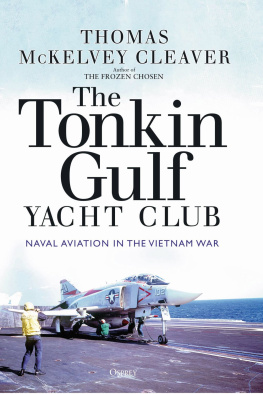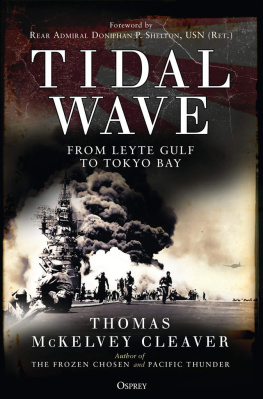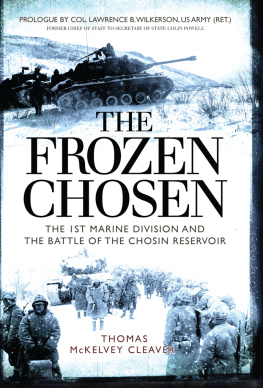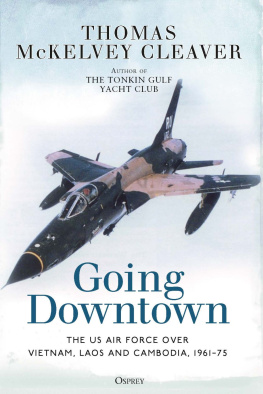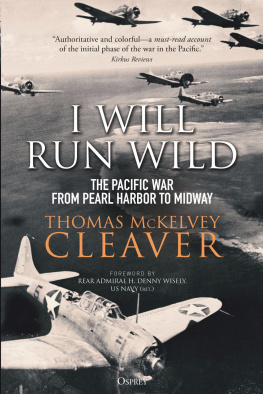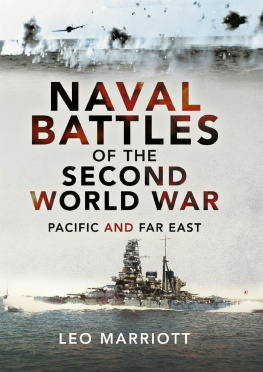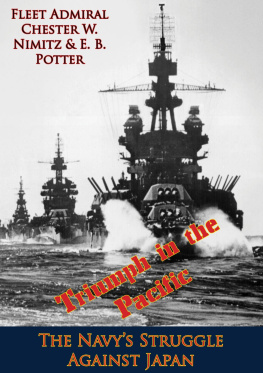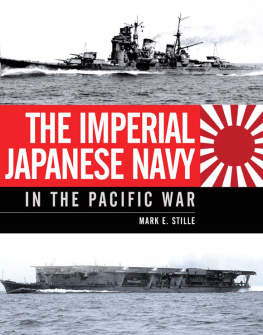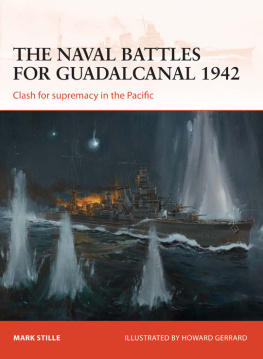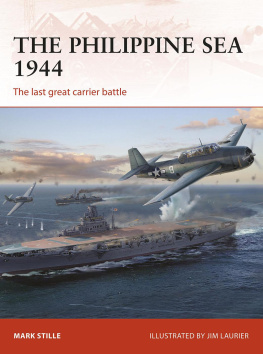

Contents
The Solomon Islands, August 1942January 1943 |
The Battle of Savo Island, August 9, 1942 |
The Battle of the Eastern Solomons, August 2325, 1942 |
The Battle of Santa Cruz, October 2627, 1942 |
The First Naval Battle of Guadalcanal, November 13, 1942 |
The Second Naval Battle of Guadalcanal, November 1415, 1942 |
The Battle of Tassafaronga, November 30, 1942 |
Naval Operations off Bougainville, October 31November 2, 1943 |
The Germany first strategy the United States had agreed to with Britain committed the US into supporting and winning the war in Europe before dealing with Japan. But Admiral Ernest King wasnt that good at waiting. Japan was running wild in the South Pacific, attacking shipping and capturing islands, and developing island fortresses. Its carriers, battleships and other combatants were formidable and combat-tested. Their aircraft and pilots were combat-honed.
This marvelous history picks up after the authors previous book, I Will Run Wild: The Pacific War from Pearl Harbor to Midway . On August 7, 1942 the US Navy landed the 1st Marine Division on Guadalcanal. Thus began the Solomons Campaign, which would become the bloodiest battle the US Navy ever fought. The Navy, Marines, Army Air Forces, and Allies worked together to confront the power of Japan, contain it, then diminish it, as they paid the awful price necessary to advance across the Pacific toward the Japanese home islands. You will see both sides of the Battle of the Eastern Solomons, the Battle of Santa Cruz, the Battle of Cape Esperance, the two Naval Battles of Guadalcanal, the Battle of Tassafaronga, and the Battle of Rennell Island aircraft carrier and battleship battles unequaled before or since.
Ground operations include the landing at Guadalcanal, the Battle of Edsons Ridge, and the Battle of Henderson Field. The Japanese often fought to the death, and the Marines were determined to oblige them. You will also get your feet wet invading Tulagi, Gavutu and Bougainville.
Meet and grow to know and understand the key players on both sides. Listen in on the conversations, messaging and radio calls of the command staff, the ship commanders, and the pilots on both sides, as the author has sewn together an amazing narrative gleaned from interviews, ships logs, squadron websites, and award citations, to tell the complete, fascinating story.
Look over Admiral Isoroku Yamamotos shoulder as he tries to understand, predict and counter the growing US presence in the South Pacific. Sail with Admiral Tanaka, and fly with Japanese pilots, like Tetsuzo Iwamoto, Hiroyoshi Nishizawa and Saburo Sakai, as they fly against ever-improving US fighters and bombers.
But also enjoy views into the US leadership, with Admirals Ernest King, Chester Nimitz, and Bull Halsey. Meet larger-than-life characters that have been immortalized by movies like PT-109 , and TV shows like Baa Baa Black Sheep and McHales Navy . There are amazing stories of John F. Kennedy, Stanley Swede Vejtasa, Joe The Coach Bauer, Gregory Pappy Boyington, Marion Carl, Richard Bong and Tommy Blackburn. You will fly on combat missions to Simpson Harbor, Rabaul, Lakunai, Vunakanau, Rapopo and Wewak. Be amazed as Paul Pappy Gunn adds additional nose guns and cannon from scrapped airplanes to make the B-25 into a strafing gunship.
Following the South Pacific campaign, there would never again be massed air battles between forces of near-equal capability such as those seen over Rabaul between October 1943 and February 1944. The war in the south Pacific was won, and the US Navy, Marines and Army Air Forces would move on to the central Pacific, en route to the Japanese home islands.
Another pilot who was there was my dad, Bob Dos, although he goes unmentioned by name. He was Commanding Officer of VF-12, flying the F6F Hellcat off USS Saratoga , as part of Task Force 38. They had been in combat since September 1943. On November 5, 1943, his log books show that he participated in a 4-hour Raid on Rabaul Shot down one Zero. He was in combat for six more months before VF-12 returned stateside. I was born a year later. 27 years after that, I was also a US Navy fighter pilot, in VF-92 flying the F-4J Phantom II on my second Vietnam War combat cruise aboard USS Constellation . On May 10, 1972, in a 2 F-4s vs. 7 MiGs fur ball over North Vietnams Kep Airfield, I shot down a North Vietnamese MiG-21. This was the first of 11 MiGs shot down that day the bloodiest air war day of the conflict. I believe my father and I are the only father-and-son both to have had aerial victories.
This book took me into the environments and battles in which my father flew, while presenting information I was not previously familiar with.
Thanks to the greatest generation for growing into the magnificent warriors and home support needed to change the course of World War II. Thanks to my dad, Captain Robert G. Dos with whom I shared so much, who passed away in 1998. And thanks to Thomas Cleaver for researching and writing this amazing book. I thoroughly enjoyed it.
Commander Curtis R. Dos, USNR (Ret)
Fighter Pilot
In February 1942, the Japanese took control of the island of New Britain and its major port, Rabaul, situated at Simpson Harbor, the best deep-water anchorage in the South Pacific. From Rabaul, Japanese forces would move west to take New Guinea, and southeast to take the Solomons. Their goal was to cut off the continent of Australia from outside support. Rabaul became the most important Japanese base south of Truk, and the most important goal of the Allies to recapture or neutralize to obtain victory in the Pacific. The campaign would take two years from the day the Japanese first came ashore to the day their air forces were forced to abandon the base to its fate.
The loss of four aircraft carriers and the majority of the highly experienced aircrews in their air groups meant that the Imperial Navy would no longer undertake offensive operations in the Pacific War. Yet this was far from a spent force. While the surviving Japanese carriers other than Shkaku and Zuikaku were not fleet carriers, they still outnumbered what the US Navy could bring to a fight, and their fliers were still the best naval aviators in the world. With Shkaku repaired from the damage inflicted on her at Coral Sea, the Mobile Fleet was a dangerous opponent and one the American Navy took on with trepidation. With regard to surface warfare capability, the Imperial Navy was far better than its American opponent in the field of night combat, which would be the centerpiece of the majority of naval action in the year following Midway.

The US Navy was still forced to husband its forces and remain conservative in their deployment, since the new navy on which construction had begun in 1940 was still a year from entering the ring. However, events overwhelmed plans and the Navy was forced to go on the offensive in the face of dangerous new developments in the South Pacific. That they were able to do so surprised the Japanese, who did not expect any US offensive action in the Pacific War before the spring of 1943. One hundred and forty days after the American victory at Midway, only USS Enterprise would remain of the carrier force so carefully built up in the years before the war. USS Saratoga had finally seen action at the Battle of the Eastern Solomons after being torpedoed shortly after Pearl Harbor, only to be torpedoed again within a matter of days of her air groups successful defense of the Guadalcanal invasion. Two weeks after that, USS Wasp would fall victim to another Japanese submarine, and five weeks after that, USS Hornet , the carrier that had launched the Doolittle Raid, would end in a watery grave at the bottom of the Coral Sea, 370 days after her commissioning. Until Saratoga could return to the South Pacific in the spring of 1943, Enterprise was the only American fleet carrier left.

